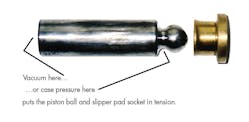In a recent article, I discussed the dilemma of installing a suction strainer on a pump intake line: damned if you do, damned if you don’t. But you have to decide one way or the other. If that’s not enough to make a hydraulics maintenance pro pull his hair out, there’s another filter location to which a similar Catch-22 applies: case drain lines.
The rationale for installing filters in piston pump and motor case drain lines is similar to the rationale for locating filtering media in the return line. That is, if the reservoir and the fluid it contains start out clean and all air entering the reservoir and returning fluid is adequately filtered, then fluid cleanliness will be maintained.
But there is a major disadvantage with installing depth filters on piston pump or motor case drain lines: The back pressure created by the filter element can cause failures. Drain line filters can cause excessive case pressure, which can result in seal failure and mechanical damage.
Seal Failure
High case pressure results in excessive load on the lip of the shaft seal. This causes the seal lip to wear a groove in the shaft, which eventually results in leakage past the seal. If case pressure exceeds the shaft seal’s design limits, instantaneous failure can occur. And the subsequent loss of oil from the case can result in damage through inadequate lubrication.
Mechanical Damage
The effect of high case pressure on axial piston pumps is the same as excessive vacuum at the pump inlet. Both conditions put the piston-ball and slipper-pad socket in tension during inlet (see image). This can cause buckling of the piston retaining plate and/or separation of the slipper from the piston, resulting in catastrophic failure.
In radial piston motor designs, high case pressure can cause the pistons to be lifted off their cam. This can occur in operation during the outlet cycle. The pistons are then hammered back onto the cam during inlet, destroying the motor. And if residual case pressure remains high when the motor is stopped, loss of contact between the pistons and cam can allow the motor to freewheel, resulting in uncontrolled machine movement.
The problems this can cause are illustrated by a situation I was involved in recently. My client asked me to locate a replacement for a radial piston motor that was no longer in production. The motor in question was powering a winch on a barge working in an offshore oilfield. The situation was urgent because the downtime was costing his company $40,000 per day. When I inquired about the nature of the failure of the original motor, he explained that the following symptoms were reported:
- Motor making a clunking noise when pulling up the load.
- Motor struggles to lift the load.
- Winch doesn’t hold the load–motor rotating backwards with the control valve in neutral.
- Load dropping even with a counterbalance valve installed to brake the motor.
Personnel on site had made the decision to tear down the motor and had emailed photos back to base. The photos of the motor internals showed no obvious failure. This confirmed my suspicions. I explained to my client that the symptoms described were consistent with high case pressure–probably as a result of a blocked or restricted case drain line. Long story short, it turned out that a well-meaning technician, who had recently completed a contamination-control course, thought it was a good idea to connect the motor case drain line back to reservoir through the system’s return filter!
Bypass Valves
Just as with suction strainers, the use of a bypass valve doesn’t resolve the case-drain filter dilemma. Filter bypass valves often leak even when they’re closed. And if/when the bypass valve does open, unfiltered oil gets into the reservoir anyway. The end result is that the depth filter has not been effective as a dirt fuse, that is, not allowing any potentially damaging particles to pass downstream, and all the while the presence of the depth element has posed a potentially damaging back pressure risk to the pump or motor.
So to avoid the problems described above, case drain lines from piston pumps and motors should be returned to the reservoir through dedicated penetrations. These penetrations must be higher than the unit’s case port and be connected to a drop-pipe inside the reservoir that extends below minimum fluid level. For the reasons outlined above, I do not generally use or recommend the installation of depth filters in case drain lines. While this does allow a small percentage of fluid to return to the reservoir unfiltered, in most applications the contamination risk is low and can be effectively managed using oil analysis and other condition-based maintenance techniques.
In applications where the risk of wear debris getting into the reservoir via the case drain line cannot be tolerated, the installation of a surface filter is a reluctant, compromise solution. This is a coarse mesh screen, ≥125 micron, and grossly oversized for the expected flow rate. The filter housing should still incorporate a bypass valve with an opening pressure lower than the maximum, allowable case pressure for the particular component (typically 5-15 PSIG). The main distinction here being, this is not intended to be a dirt fuse, it’s a “rock stopper.” This type of filter will still allow particles smaller than 125 microns to get into the reservoir. But as a general rule, particles of this size won’t cause a catastrophic failure in a single pass. They may cause some three-body abrasion until they are captured by the other filters in the system, but the components will live on. And a relatively coarse, grossly oversized screen presents a lessor restriction in the case-drain line than a depth filter.
Filter with Caution
The primary objective of contamination control is to extend the service life of hydraulic components. Like suction strainers, case drain filters can reduce the service life of piston pumps and motors and therefore their installation in pursuit of this objective is a paradox. Effective contamination control is achievable using alternative filter locations that do not compromise component reliability. However, if case drain filters are included in a system, precautions must be taken to ensure that they do not cause damage to the components they were installed to protect.



